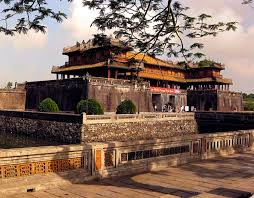Geography of Hue
Hue is a province located in the northern part of Central Vietnam. It is encompassed between Quang Tri Province to the north, Da Nang and Quang Nam provinces, to the south (with the boundary of the Hai Van Pass), the Eastern sea to the east and Lao PDR to the west (with the boundary of the Truong Son Mountain Range). The provincial capital, Hue, the old imperial city of Vietnam under the Nguyen Dynasty, is 660 km south of Hanoi and 1,080 km north of Ho Chi Minh City.
At the meeting of the 17th session of the World Heritage Committee (WHC) in Columbia, from the 6th to the 11th of December 1993, UNESCO has come to the decision of recognizing the architectural ensemble of Hue as a world cultural heritage. On 2 August 1994, the delivery of the recognizing text has been organized at the Imperial Palace of Hue, with the participation of many international, national and local personalities, as well as representatives of the population of Hue. Great enthusiasm has been generated in the country through the broadcast of this news. This was a noteworthy event in the cultural history. For the reason that Hue is the first site in Vietnam ever listed in the World Heritage list.
As to the cultural value, a World Cultural Heritage Site, like the city of Hue, has to:
Be representative of an original artistic achievement, a masterpiece created by Man’s hands;
Have a great value for its building technique or its architecture in a general development plan for a city or in a program for the embellishment of the sight of a world cultural zone;
Be representative of an architectural ensemble of an important historical period; be closely related to important events, to ideas or beliefs having a great influence or to famous historical personalities.
Besides, for a cultural property to be internationally recognized, it has to be fully confirmed on a juridical level, and it must possess a managing organization ensuring its good conservation. The architectural ensemble of Hue meets these requirements; it is embedded with highly humanistic values, and may be compared with the other cultural properties, rare and precious, in this World.
In the closing report of the above-mentioned meeting, the WHC has briefly assessed the value of Hue as follows. “The architecture of Hue, which has been the Capital of a unified Vietnam, built at about the beginning of the 19th century, combines the oriental philosophy with the traditions of Vietnam. Intimately mingled with the natural environment, the beauty and special richness of the architecture and decorative art of the building are an original image of the Vietnamese monarchy at its most prosperous period”.
Hue Climate
The weather is submitted to tropical monsoon climate divided into four distinct seasons: fresh spring, very hot summer, mild autumn and windy, cold winter. The dry season lasts from March to August. It is hot with temperate rarely reaches to 39.5ºC. The rainy season lasts from September to February. It is quite cold with average temperature is 19.7ºC, but sometime down to 8.8ºC. In this time, it rains a lost, sometime lasts all day. If tourist would to avoid rainy, they come to Danang City, 108km from south of Hue. In the mountain area, the weather is cool with the annual temperature is between 9ºC and 29ºC. The most convenient time to visit the area is from November to April.
Hue Tourism
Hue offers very diversified and beautiful landscapes. Nature and human beings create a harmoniously beauty with Bach Ma (White Horse) National Park and other attractive beaches such as Thuan An, Lang Co and Canh Duong.
The province provides a well-balanced blend of royal heritage and folk culture. As a matter of fact, tourists discover dozens of handicraft villages, with annual festivals that are painstakingly organized.
Hue is also an important center of Buddhism. In Hue and its surrounding still exist tens of pagodas constructed more 300 years ago, and hundred of temples and pagodas built in the early 20th century. Besides, tourist is able to enjoy many traditional famous dishes and find out about sophisticated handicraft here.
Hue Citadel has been recognized as a World Cultural Heritage Site by UNESCO since December 1993, Hue Royal Musical (Nha nhac) has been declared as a World Intangible Cultural Heritage since November 2003.
Hue Transportation
Transportation by train, road, air and water routes is very convenient.
Train: The Thong Nhat Express trains from Hanoi to Ho Chi Minh stop at Hue Railway station. The local trains come to some other provinces.
Air: Phu Bai Airport serves flights: Hue – Ho Chi Minh City and Hue – Hanoi.





